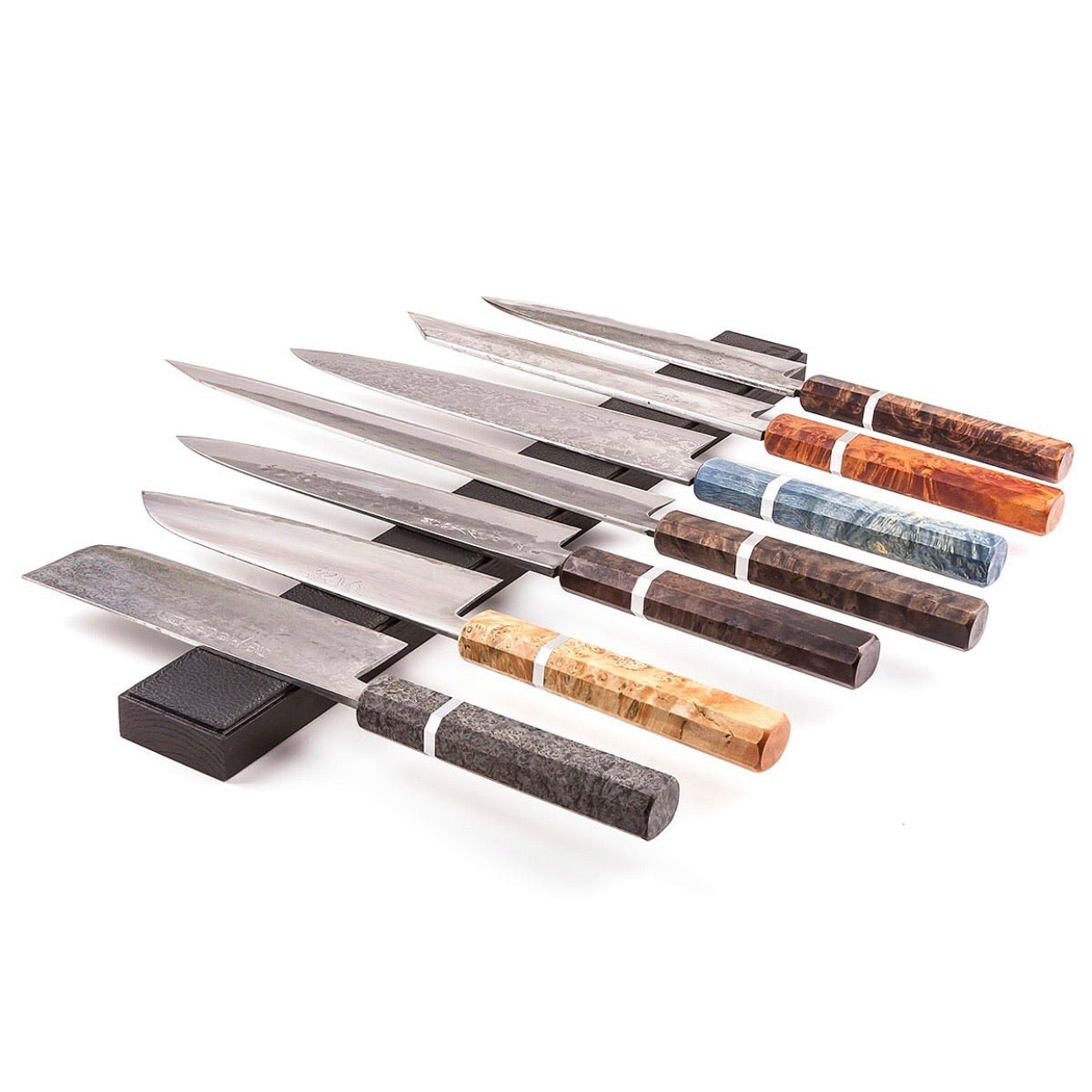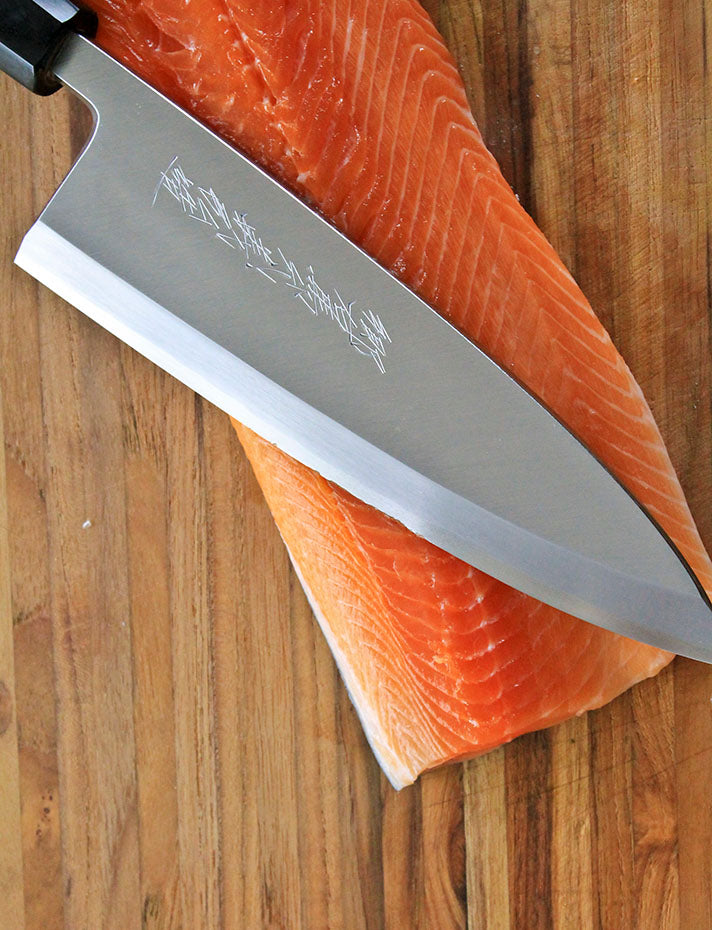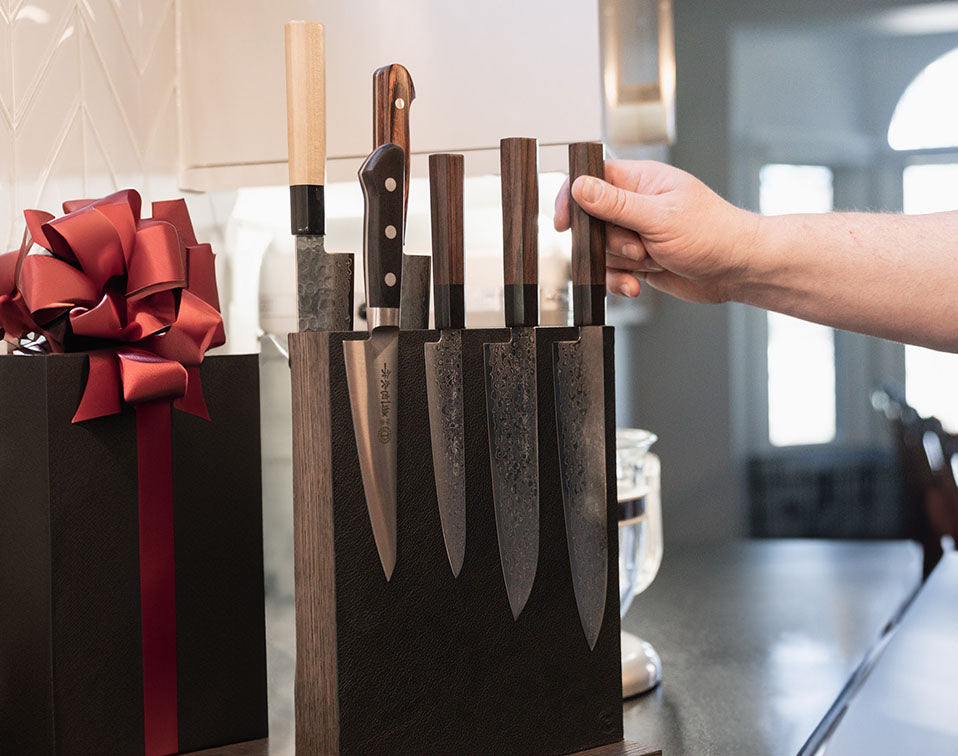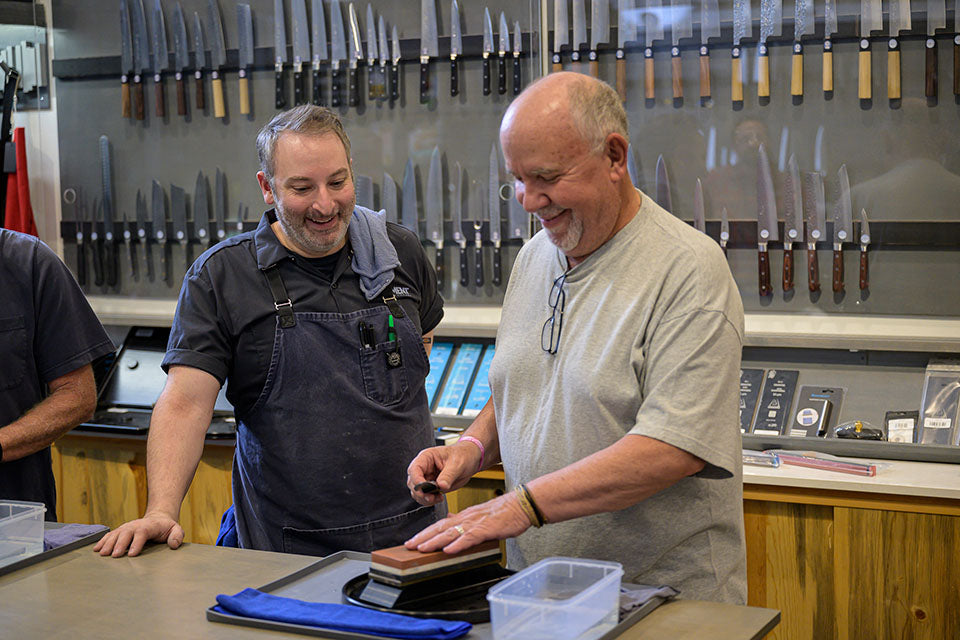Knife Care

Knife Care
How To Care For Your Steel
Learn maintenance tips to prevent rust, cultivate a protective patina, and achieve the perfect sharpness. Whether you have low-maintenance stainless steel or high-maintenance carbon steel knives, our advice ensures longevity and peak performance for your culinary tools.
Knife Care - Click each to learn more
Stainless Steel - Little to no stain
For steel to be considered stainless, it must contain at least 13% chromium by weight in its alloy composition. This chromium is essential because it reacts with oxygen to form chromium oxide, a thin, clear, and hard protective layer. This layer essentially acts as a barrier, preventing rust and corrosion. However, stainless steel knives can still rust under adverse conditions, especially if the protective layer is damaged.
Why Stainless Steel Can Rust
If the chromium oxide layer is compromised—such as by abrasive scouring pads, harsh detergents, or high humidity—the exposed steel beneath is vulnerable to rusting until the protective layer reforms, which typically takes about 24 hours. This is why it's important to treat your knives with care and avoid damaging this natural defense.
Japanese Stainless Steel
Japanese stainless steels are often formulated with higher carbon content than typical Western stainless steels, allowing for a sharper edge and superior edge retention. However, this increased carbon content makes these knives more prone to rust if not cared for properly. While they are more resistant than carbon steel knives, they are still susceptible to rust if left to drip dry or, worse, put through the dishwasher.
Care Instructions for Stainless Steel Knives:
- Hand Wash Only: Always hand wash your knives with mild soap and warm water immediately after use. Avoid harsh scrubbing pads that can scratch the blade and damage the protective chromium oxide layer.
- Dry Immediately: Do not allow your knife to air dry. Wipe it dry immediately after washing with a soft cloth or towel. Even stainless steel knives can develop rust spots if left damp.
- Avoid the Dishwasher: Never place your knife in the dishwasher. The high heat, detergents, and water pressure can degrade both the blade and handle. The high moisture and heat in dishwashers can cause handles to crack or warp over time, while the jostling of knives against other items can dull or chip the blade.
- Store Properly: After cleaning and drying, store your knife in a knife block, on a magnetic strip, or in a knife guard or sheath. Avoid throwing it into a drawer where it can bump into other utensils, which can damage the blade and handle.
- Sharpen and Hone Regularly: To maintain your knife’s peak performance, it's essential to regularly sharpen and hone the blade. A sharp knife not only cuts more efficiently but is also safer to use, as it requires less force and is less likely to slip. Regular honing realigns the blade's edge, keeping it sharp between sharpenings, while periodic sharpening restores the edge when it begins to dull. Neglecting this can lead to a dull blade, which can be more dangerous as it demands extra pressure and increases the risk of accidents.
Key Takeaways:
- Japanese stainless steel knives have a higher carbon content, which makes them sharper but also more vulnerable to rust if not properly cared for.
- Always hand wash and dry knives immediately to protect both the blade and handle.
- Never use the dishwasher for your knives, as it can damage both the blade's edge and the handle material.
By following these care tips, you can ensure your stainless steel knives stay sharp, rust-free, and in excellent condition for years to come.
Carbon Steel - Reactive To pH
Carbon steel knives are not stainless but are highly regarded for their excellent edge retention, wear resistance, and sharpness, but they are reactive to acidic substances and prone to rust. Exposure to items with an acidic pH can lead to spotting and staining, resulting in the formation of a patina. This patina is a natural layer of oxidation that develops over time. While it may initially appear as discoloration, a well-cultivated patina acts as a protective barrier against rust and contributes to the knife's unique beauty.
The rate at which carbon steel knives rust can vary depending on the specific alloy. To prevent rusting, it's crucial to wipe the blade dry during heavy use and immediately after washing. If rust develops, you can remove it using a rust eraser or fine-grit wet/dry sandpaper. Avoid using heavy abrasives, such as metal scouring pads, as these can scratch the blade and create areas where moisture can accumulate, leading to significant rust damage.
Dishwasher Warning
Never place a carbon steel knife (or any knife) in the dishwasher. The combination of moisture and high heat will accelerate rust formation and damage the blade.
Key Points:
- Reactivity: Carbon steel is reactive to acidic substances, which can cause rust and staining.
- Patina Formation: Over time, a natural patina develops, providing protection against rust and enhancing the knife's beauty.
Care Instructions:
- Wipe Dry: Always wipe the blade dry during heavy use and immediately after washing to prevent rust.
- Rust Removal: If rust appears, use a rust eraser, fine-grit wet/dry sandpaper, or a cleanser such as Bar Keepers Friend to gently remove it. Avoid heavy abrasives like metal scouring pads, which can scratch the blade and promote further rust.
- Avoid Dishwashers: Never put carbon steel knives in the dishwasher. The moisture and heat can cause significant rusting and damage.
- Storage Protection: Apply a light coat of Tsubaki oil or mineral oil before storing your knife. These food-safe oils protect the steel from humidity without becoming tacky or rancid.
Takeaways:
- Regularly Wipe and Dry: Consistently wiping and drying your knife after use is essential to prevent rust and maintain its performance.
- Cultivate a Patina: Allowing a patina to develop is beneficial, as it provides natural protection against rust and adds unique character to your knife.
- Use Appropriate Cleaning Tools: When removing rust, opt for gentle cleaning methods to avoid damaging the blade.
- Storage Matters: Properly storing your carbon steel knife with oil protection ensures longevity and preserves its beauty.
By following these guidelines, you can preserve the knife's performance and aesthetic appeal, making it a treasured part of your culinary arsenal.
Sharpening & Honing - Differences
Sharpening is the process of removing material from the blade to create an edge or bevel. This process generates burrs, which play a crucial role in sharpness.
What is a Burr?
A burr is defined as "a rough edge or ridge left on an object (especially metal) by the action of a tool or machine." Burrs are formed at the apex of a knife's edge during sharpening. Once created, they are refined and aligned, acting as tiny micro serrations. They assist the knife in effortlessly cutting through food products, even though they are too small to be seen with the naked eye.
After sharpening, when the knife makes contact with food or cutting surfaces, the burrs can become bent out of alignment. This is where honing becomes essential. Honing realigns the burrs, restoring the knife's sharpness. However, burrs can also fall away; when enough burrs are lost, there may be nothing left to hone back into place.
Honing Techniques
Honing can be done using either a honing steel or a strop:
- Honing Steels/Honing Rods: These can be made of steel, diamond-coated, or ceramic. They help realign the blade's edge effectively.
- Strops: Typically made of leather, diamond resin compounds, or denim. Some people rub a diamond polishing compound into the leather to aid with polishing the edge.
For stainless steel knives, we recommend using honing rods with a rough or medium grit, whether steel or diamond-coated. The rougher grit easily breaks through the chromium oxide. Conversely, carbon steel knives respond very well to honing and sharpening due to their finer grain structure and lack of chromium, which forms chromium oxide. These knives can be honed effectively using fine-grit or ceramic rods, which have a smoother surface.
Resharpening and Maintenance
We suggest honing as needed between sharpening sessions. Additionally, honing can be performed at the end of the sharpening process to ensure the burrs are perfectly aligned.
In summary, sharpening creates the edge and refines and polishes it, generating, refining, and aligning burrs in the process. Understanding the interplay between sharpening and honing will help maintain the performance and longevity of your knives.
Sharpening Frequency & Sharpening Equipment
For home chefs who cook frequently and don’t sharpen their own knives, it’s recommended to have them professionally sharpened every three to six months. Professionals know to sharpen often, and if you're sharpening your own knives, increasing the frequency is beneficial. The more often you sharpen, the less work and fewer steps are required each time.
Sharpening by hand on stones produces the best edge but requires considerable skill and practice. If this method doesn’t appeal to you, consider using a pass-through sharpener. However, not all sharpeners are created equal. For manual sharpeners, those with a wheel tend to perform best. Whether using a manual or powered sharpener, apply only about a pound of downward pressure. Let the device do the work—don’t force it.
Sharpening stones come in various types: water stones, oil stones, and dry stones, which can be natural, synthetic, or diamond-coated. These stones range in grits, from rough to medium to fine. Hand sharpening with stones can be as simple or as detailed as you like. For simplicity, we recommend using a 1,000-grit stone, which is rough enough to sharpen while still smooth enough to leave a refined edge. However, since a 1,000-grit stone doesn’t have strong cutting power, you’ll need to sharpen regularly.
If your knife is dull, start with a rough stone (200 to 400 grit). It’s essential to progress through grits in modest increments—don’t jump from a 400 grit directly to a 3,000 grit. Instead, use a 1,000-grit stone in between.
Just as important as maintaining a sharp knife is caring for your sharpening equipment. Always keep your sharpening stone’s surface flat by fixing (lapping) the high points once the surface becomes dished. Follow the manufacturer's instructions for storage, care, and maintenance.
Finally, use caution when sharpening with powered equipment, such as belt sanders and grinders. These can easily remove too much metal, potentially altering the profile and shape of your knife. Additionally, be careful to avoid overheating the steel, as this can remove the temper, making the blade soft and less able to hold an edge.
Dos & Don'ts
Do's
- Always Maintain a Sharp Edge: A sharp blade produces cleaner cuts and makes work easier and safer. If you cook often, we recommend having your knives sharpened every 3 to 6 months.
- Store Knives Properly: Always store your knives in a knife block or knife bag, on a magnetic strip, or with blade guards to protect the edge and prevent accidents.
- Use the Right Knife for the Job: Choose the appropriate knife for different tasks (e.g., a chef knife for chopping, a paring knife for peeling) to avoid damage and ensure safety.
- Grip the Knife Correctly: Hold the knife handle firmly while resting your thumb and index finger on the blade for control and stability.
- Use the claw: With the hand opposite to the one holding the knife, tuck your fingertips below your knuckles to protect them from the knife's edge.
- Clean Knives Immediately After Use: Washing your knife promptly prevents food from sticking, makes cleaning easier, and reduces the chance of damaging the edge.
- Use a Cutting Board: Always cut on a cutting board made of wood or soft plastic to protect your knife’s edge from dulling.
- Regularly Hone Your Knives
Maintain the sharpness of your knives by honing them regularly. This helps realign the blade edge and ensures consistent cutting performance. - Use a Proper Cutting Technique
Practice a rocking motion when cutting, allowing the knife’s blade to glide through food without excessive force. This technique reduces the risk of injury and helps maintain a sharp edge. - Inspect Your Knives Regularly
Check your knives for any signs of damage, such as chips or bends in the blade. Addressing these issues early can prolong the life of your knives.
Don'ts
- Never Put Your Knife in the Dishwasher: The high heat and water pressure can damage the handle and promote rusting.
- Don’t Leave Knives in the Sink: Avoid soaking your knives or leaving them in the sink, as this can cause rusting (especially for carbon steel knives) and presents a safety hazard.
- Don’t Cut Frozen Foods: Avoid using your knives to cut through frozen foods or bones, as this can chip or damage the blade.
- Never Use Your Knife as a Screwdriver or Hammer: Prying at equipment or bones may bend or chip the blade's edge, while hammering can chip the edge or snap the tip.
- Don’t Twist or Pry with the Knife: Never twist or pry with a knife blade, especially when cutting thick or dense materials, as it can cause the blade to bend, chip, or break.
- Don’t Use Excessive Force: Let the sharpness of the knife do the work. Applying excessive force can damage both the knife and what you’re cutting.
- Don’t Cut on Hard Surfaces or Scrape the Blade to Move Food: Avoid cutting on hard surfaces like glass or granite, as this will dull your knife quickly. Use the spine of the knife to slide ingredients off the board instead of the sharp edge, which can dull the blade.
- Don't Store Knives Loose in a Drawer
Avoid keeping your knives loose in a drawer, as this can cause nicks and dull the edges, It can also be dangerous reaching into a drawer with exposed edges. Instead, use a knife block, magnetic strip, or blade guards. - Don't Use a Knife with a Damaged Edge
If your knife has a chipped or bent edge, refrain from using it until it has been repaired or sharpened. Using a damaged knife can lead to further damage and increase the risk of injury.
Don't Attempt to Catch a Falling Knife
If a knife slips from your hand, don’t try to catch it. Step back and let it fall to avoid potential injury.
Knife Care
Knife Storage & Organization
On the go or in your kitchen, organizing and protecting your investments is important. Everyone's kitchen spaces and needs are different. Learn about edge guards, knife rolls & bags, magnetic strips, knife blocks, and in-drawer options.

Knife Storage And Organization
Knife Guards
Knife Guards come in different styles. Some cover the blade by inserting it from the end. Others slip over the knife from the edge. Guards can be made from an array of materials like plastic, wood, or leather. Protecting the knife's edge is important when placing knives into chef rolls or knife bags. This keeps the sharp edges from banging around and protects fingers as well as damage to the bags. Furthermore, if knives are going to be stored in a drawer without an in-drawer knife organizer, it's a good idea to put edge guards over them.

Knife Storage And Organization
Knife Luggage
Knife luggage comes in a variety of options, Rolls, Bags & Backpacks. These are great options for people on the go. Always protect your fingers, knives, and luggage with knife guards.

Knife Storage And Organization
Magnetic Wall Strips
Magnetic wall strips are a great way to showcase and store your cutlery. Wall-mounted storage can save counter space too. When removing a knife from the magnet, it is recommended to gently twist the handle, bringing the cutting edge of the knife away from the strip first. Then the knife will come away easily and avoids scratching your knives if the magnet or metal is exposed. (Sometimes the magnets are covered in leather or they are hidden within wood). This order of operations will also help keep the leather or wood from cuts and scratches. When placing a knife onto the magnet, ever so slightly turn the knife's spine toward the strip first. This will keep the knife's cutting edge from damaging the strip.

Knife Storage And Organization
Knife Blocks
Knife Blocks come in several sizes, styles, and orientations. They can have magnets or, more traditionally, slots to accommodate the knife’s blade. Some claim that traditional blocks with slots can dull your knives. This is technically true to a small degree, but not necessarily, to a noticeable extent. The bigger concern is that these slots can harbor bacteria and germs. It is always suggested to put knives away, washed and completely dried.
In-drawer knife blocks are a great way to organize your cutlery and help open up more counter space. They keep the blades from banging against one another or other utensils. Always put knives away clean and dry, so the slots don't breed germs and bacteria.

Learn Center
- Choosing a selection results in a full page refresh.
!













































